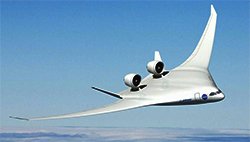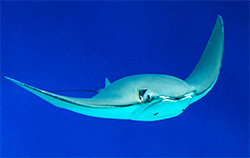What If Airplanes Looked Like Stingrays?

"It’s a bird! It’s a plane! It’s a stingray?” Airplane manufacturers and NASA have been researching a more streamlined design that blends the airplane’s wings into its body and removes its tail, giving them the appearance of flat-bodied stingrays. These hybrid or blended wing body (BWB) planes would use both the body and the wings to generate lift, unlike today’s conventional tubular planes that rely only on the wings. This, coupled with the seamless body that helps reduce drag, makes them more fuel efficient and reduces carbon pollution. BWB planes would likely be lighter than conventional planes, increasing their fuel efficiency even more. And they could also significantly reduce noise at and around airports. 1 No full-scale BWB planes are operational yet, and it likely will be awhile before they are commercialized. Because of the potential for BWB planes to significantly reduce emissions, we ask, “What if airplanes looked like stingrays?”

If half of today’s large airplanes had blended wing bodies, this could:
- Prevent up to 76 million metric tons of CO2 from being emitted globally per year
- Be equivalent to taking about 16 million cars off the road7
What’s the Bottom Line?
Commercial passenger flights departing within and from the U.S. account for about a quarter of global airplane CO2 emissions. 2 As global population and incomes rise, demand for air travel is expected to climb. The U.S. could see a 36% rise in airplane emissions in the coming decades, 3 while worldwide emissions from airplanes could triple. 4
According to NASA studies, commercial airplanes with hybrid or blended wings have the potential to cut fuel consumption in half when combined with advanced aerodynamics and engine design.5 Several early BWB concepts showed they could accommodate over 400 passengers and travel farther than 6,000 miles.6 We consider what would happen if half of longer trips on large “widebody” planes were taken using BWBs.
In 2018, commercial passenger flights around the globe accounted for 747 million metric tons of CO2, with about 40% of emissions coming from widebody planes. If half of today’s large airplanes had blended wing bodies, this could prevent up to 76 million metric tons of CO2 from being emitted globally each year.8
Did you know that the fuel efficiency of planes has improved by 80% per seat since the 1960s? 9
Other potential ways to reduce airplane GHG emissions:
- Low carbon fuels
- Light-weight carbon fiber bodies
- More efficient engines
What Would it Be Like?
A passenger would have a very different travel experience. Larger and wider plane doors and aisles could ease boarding times. Instead of seating passengers in rows, BWB planes could offer variable seating options. If you wanted to see the view, you might have to rely on a sidewall-mounted screen showing videos of the outside. And a double-deck configuration would likely be typical. 10
Ready to board? Here are a few examples showing how much lower CO2 emissions could be using BWB planes.

- BWB design has a lift-to-drag ratio that is 50% greater than a conventional airplane
- Flattened body and airfoil design produce most of the lift
- Wing and fuselage are integrated, which essentially results in a large flying wing
Case 1: Have you always wanted to swim with stingrays (and sharks, for a true adventure)? You can fly from Atlanta to Johannesburg—about 17,000 miles roundtrip.

A BWB could save up to 351 tons of CO2, which is equivalent to the emissions from electricity used in about 60 homes a year. 11
Case 2: Prefer turtles to sharks? You can fly from Atlanta to Honolulu—about 9,000 miles roundtrip.

A BWB could save up to 143 tons of CO2, which is equivalent to the emissions from charging over 18 million smartphones.
Blended wing body airplanes are many years away from commercialization. And while there are still technical hurdles to overcome before we can realize the GHG reductions from this plane design, we don’t have to wait for pigs to fly. Just stingrays.
1For more information, visit NASA’s news blog: A Wing and a Prayer .
2The International Council on Clean Transportation, CO2 emissions from commercial aviation, 2018 (September 2019) (pdf) (269 KB).
3 Estimated growth from 2019 to 2050. U.S. Energy Information Administration, Annual Energy Outlook 2020, Table 19: Energy-Related Carbon Dioxide Emissions by End Use.
4 Refers to growth in international aviation emissions, as defined by the International Civil Aviation Organization. See ICCT citation #2.
5 NASA, New Aviation Horizons Initiative Lithographic (pdf) (2.6 MB); Nickol, Craig L. and William J. Haller, Assessment of the Performance Potential of Advanced Subsonic Transport Concepts for NASA’s Environmentally Responsible Aviation Project (2016) (pdf) (1.18 MB)
6 International Air Transport Association (IATA), Aircraft Technology Roadmaps to 2050, found at: IATA’s Net Zero roadmaps.
7Assumes 4.6 metric tons CO2 per passenger vehicle, found at: Tailpipe Greenhouse Gas Emissions from a Typical Passenger Vehicle.
8Estimates are based on percent of widebody plane departures and carbon intensity per distance traveled. See ICCT, CO2 emissions from commercial aviation, 2018 (September 2019) (pdf) (269 KB).
9ICAO Environment, On Board A Sustainable Future: ICAO Environmental Report 2016 (pdf) (46.4 MB).
10 Granzeier, Werner. Blended Wing Body cabin design insights (March 20, 2020).
11Estimates are based on 50% of fuel burned round trip, from ICAO’s Carbon Emissions Calculator; comparisons based on EPA’s GHG Equivalencies Calculator (accessed June 15, 2020).
